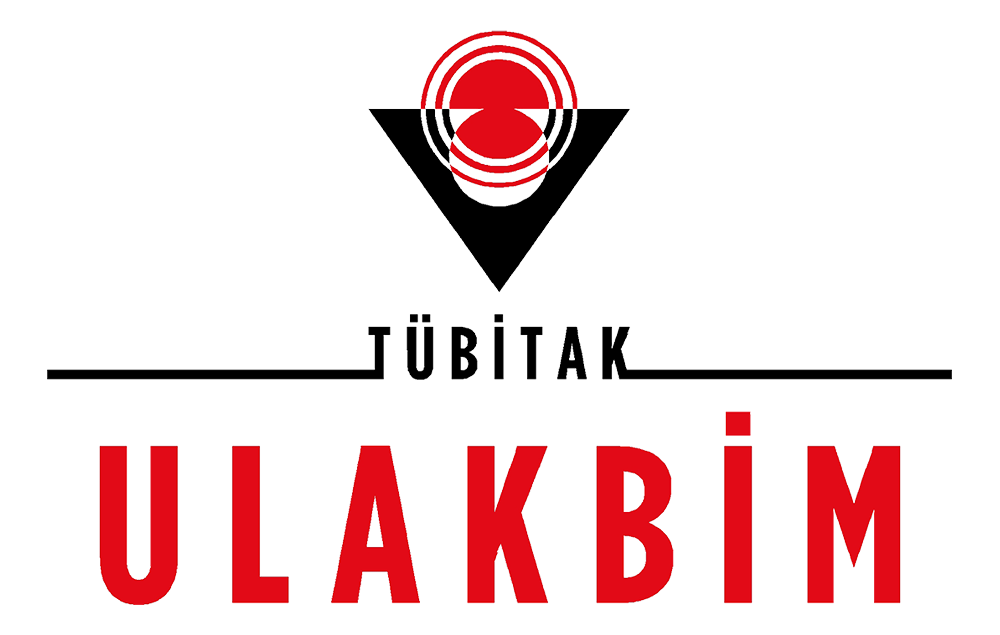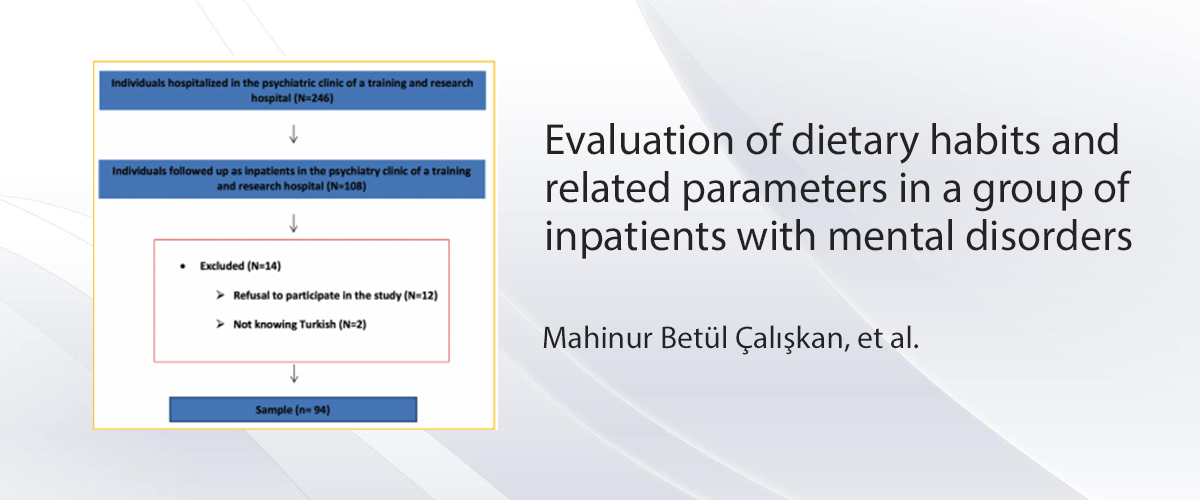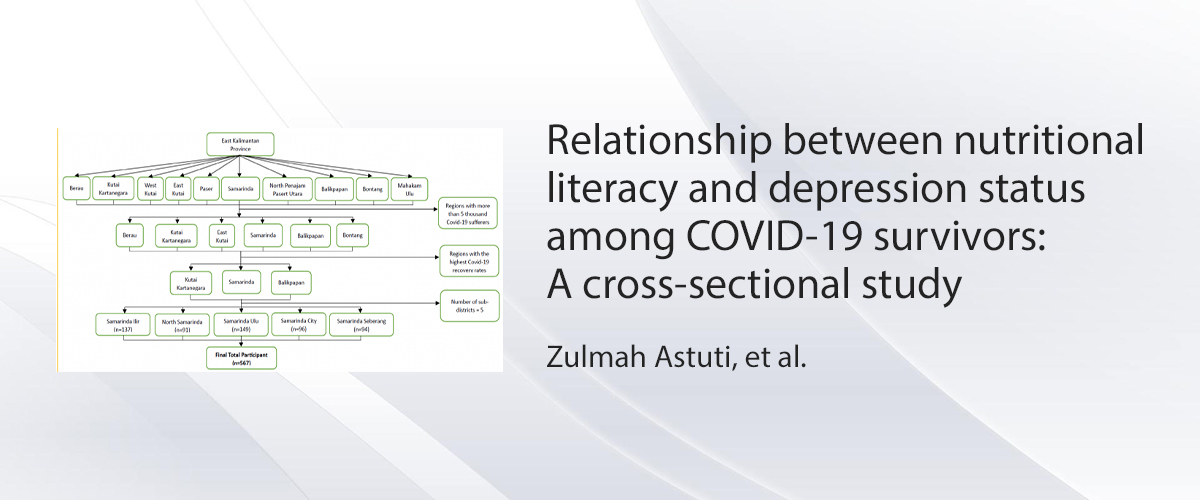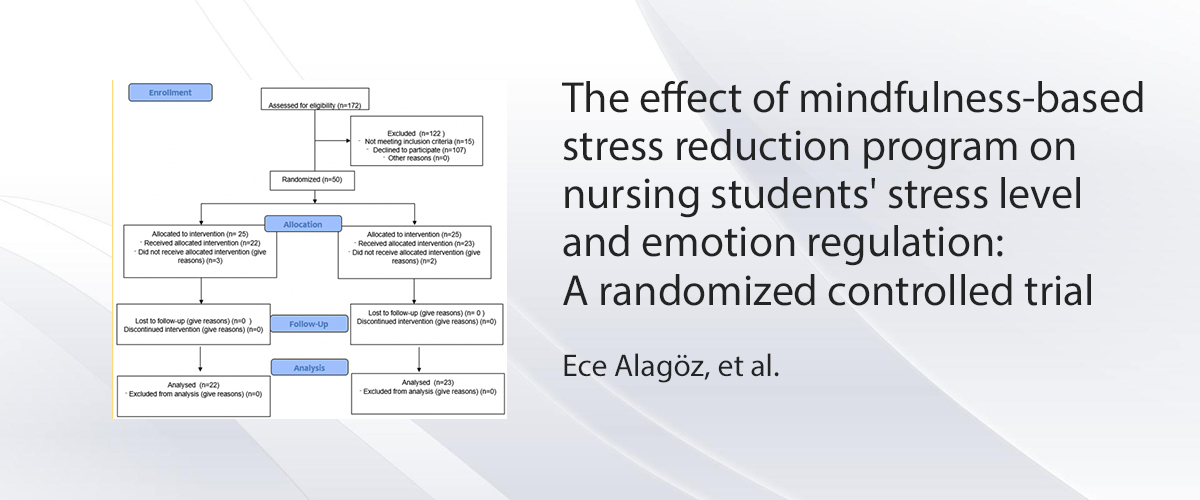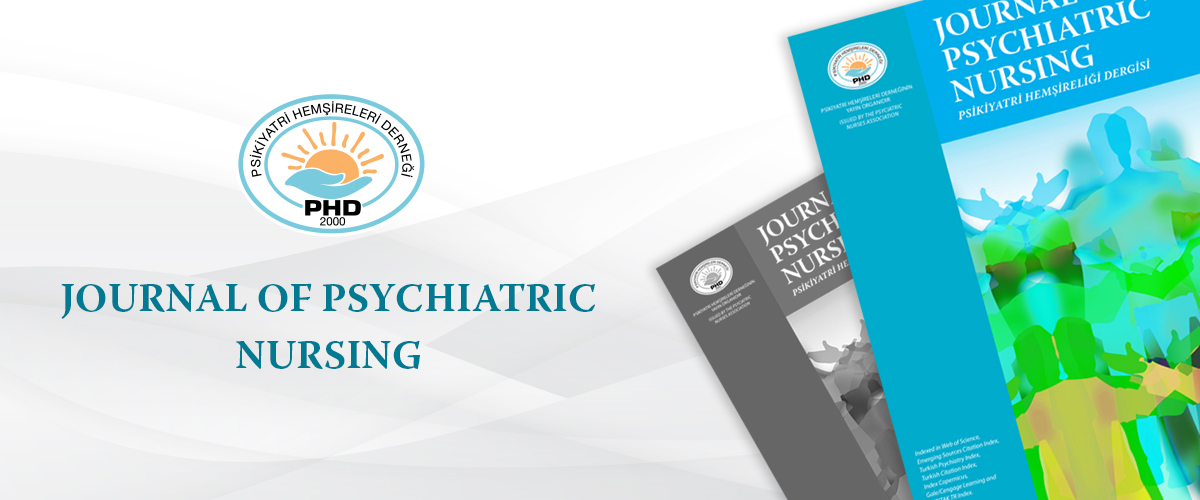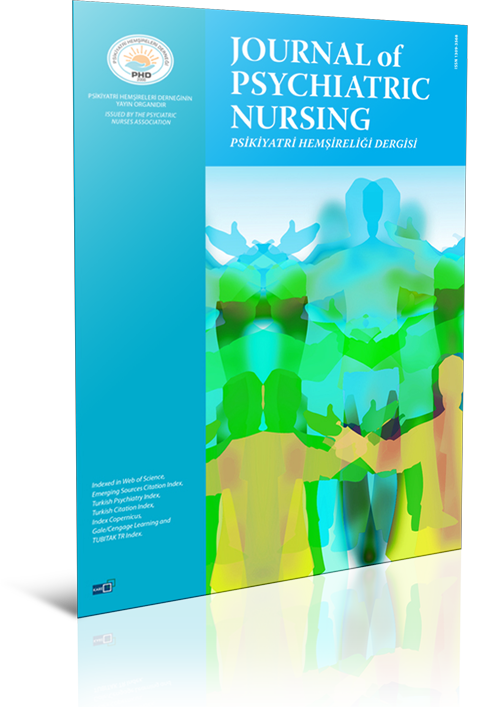
INFORMATION FOR AUTHORS
Aim and Scope
The Journal of Psychiatric Nursing is the publication of the Psychiatric Nurses Association. The journal is an open-access, peer-reviewed periodical that offers scientific, theoretical, and philosophical studies of psychiatric nursing practice, training, management, and research, including, primary mental health services, treatment and psychiatric rehabilitation, and articles on mental health and psychiatric disorders from different fields. The journal is published in English.
The journal publishes original research articles, systematic reviews and meta-analyses, literature reviews, case reports, letters to the editor, and educational articles reflecting new knowledge and developments in psychiatric nursing and mental health.
The annual volume comprises four issues and is published online in https://phdergi.org/
Introduction to the Journal of Psychiatric Nursing
The Psychiatric Nurses Association, founded in 2000, is a professional organization of psychiatric nursing that serves the important purpose of developing and sharing the valuable role of this profession in Turkey. Article (g) of the organizational objectives in the charter of the Psychiatric Nurses Association is "To ensure that the association has a publication that includes scientific studies, to publish professional publications (newspapers, brochures, almanacs, books), and to support these publications." To achieve this objective, the Journal of Psychiatric Nursing was created in 2010 as a peer-reviewed publication that includes scientific, theoretical, and other studies related to psychiatric nursing practice, education, management, and research. The journal is designed to contribute to expanding knowledge of psychiatric nursing and psychiatry, share professional knowledge and experiences in a scientific environment, and create a valuable archive.
Articles must be evaluated and approved by the editorial board and the scientific advisory board prior to publication. Manuscripts deemed unsuitable for publication will not be returned. All rights to published articles belong to the journal. If anything is quoted from the journal, the source should be cited as the source.
Editorial and publication processes of the journal are conducted in accordance with the guidelines of the International Council of Medical Journal Editors (ICMJE), the World Association of Medical Editors (WAME), the Council of Science Editors (CSE), the European Association of Science Editors (EASE), and the Committee on Publication Ethics (COPE), the National Information Standards Organization (NISO), and the Directory of Open Access Journals (DOAJ) principles of transparency and best practice in scientific publishing (www.doaj.org/bestpractice).
The Journal of Psychiatric Nursing is indexed in Gale Engage (since 2010), the Scientific and Technological Research Council of Turkey (TUBITAK) Turkish Medical Index (since 2011), the Turkish National Citation Index (since 2011), EBSCO (since 2012), the Turkish Psychiatric Index (since 2014), and the Web of Science Emerging Sources Citation Index (ESCI) (since 2015), Directory of Open Access Journals (DOAJ) (since 2018), Scopus (since 2019), and ProQuest (since 2020).
Abstracting and Indexing: Web of Science - Emerging Sources Citation Index (ESCI), SCOPUS, TÜBİTAK ULAKBİM, Türk Psikiyatri Dizini, Türkiye Atıf Dizini, Gale/Cengage Learning
Language: Accepted manuscript will be published in English. Articles submitted to the system may be written in British or American English but should not be a mixture of the two. It is necessary to work with an internationally certified translation center for language editing and submit the document to the system.
Scientific Responsibility: The author(s) bear responsibility for the material presented in the article. Statements and opinions expressed in published articles reflect the views of the author(s) alone. The editors, editorial board, and publisher do not accept any responsibility or liability for this material. Articles may not have been published elsewhere or submitted for publication to another journal.
Copyright: Authors agree to transfer copyright privileges upon submission to the journal. This transfer takes effect upon acceptance for publication. No part of published material may be used for any other purpose without the written permission of the publisher.
Creative Commons License: The Journal of Psychiatric Nursing articles are licensed under the Attribution-Non-Commercial-Share A like 4.0 International (CC BY-NC-SA 4.0) version. The author grants the right to share and use original work with the condition that it be appropriately credited, it may not be used for commercial purposes, and secondary products must also be made available under the same terms of use.
Conflict of interest: Authors and all individuals involved in the evaluation of articles are required to disclose existing or potential conflicts of interest, including financial, consultancy and institutional relationships, that may lead to even a perception of potential bias or conflict of interest. All financial grants or other support for the research must be disclosed. The International Committee of Medical Journal Editors (ICMJE) Potential Conflict of Interest Notification Form must be completed and submitted by all of the contributing authors. Resolution of conflict-of-interest inquiries is conducted by the journal's editorial board according to COPE and ICMJE guidelines. The editorial board handles all appeal and complaint cases according to COPE guidelines, and the editor(s)-in-chief is the ultimate authority in the decision-making process.
Originality: Originality is a crucial criterion for a manuscript to be accepted for publication. The publisher reviews submissions using iThenticate software to detect plagiarism and other unethical practices. Plagiarism detected at any stage is sufficient for the article to be rejected.
Open Access: The Journal of Psychiatric Nursing is an open-access journal. Users can access all content at no cost. Articles published in this journal are available for use by researchers and other readers without permission from the author or the publisher, provided that the author and the original source are cited.
Journal of Psychiatric Nursing Article Processing Fee: The Journal of Psychiatric Nursing charges a processing fee of 200 USD for all articles, except for Letters to the Editor, submitted after 07.08.2023, which are accepted for publication following a scientific review.
Any financial contribution or support from third parties for an article must be disclosed at the time of initial submission. In cases where the payment is made by the author or a third party (other than the author's institution), authors must indicate this information on the title page and the ICMJE Disclosure Form.
Author fees or waivers do not affect the editorial decision-making process. All submissions are evaluated by the Editorial Board and external referees based on scientific quality and ethical standards. Payments for article processing fees do not impact the evaluation outcome or publication priority of the article.
This policy aligns with the Inter-Universities Council statement dated January 25, 2022, concerning predatory journals.
Payment details will be sent to you once your manuscript has been accepted.
AUTHORSHIP
All those designated as authors should meet all four criteria for authorship below as defined by the ICMJE, and all who meet the four criteria should be identified as authors. Other contributors may be recognized in the acknowledgements section.
- Substantial contributions to the conception or design of the work; or the acquisition, analysis, or interpretation of data for the work; AND
- Drafting the work or revising it critically for important intellectual content; AND
- Final approval of the version to be published; AND
- Agreement to be accountable for all aspects of the work in ensuring that questions related to the accuracy or integrity of any part of the work are appropriately investigated and resolved.
The Journal of Psychiatric Nursing requires that authors submit a signed and scanned version of the author contribution and copyright transfer form with the initial submission (https://phdergi.org/phd_copyright_transfer.pdf). This document will be used to assign and protect authorship rights. Please note that the sequence of names used on the form will be used in the article. Later changes to the list of authors are not permitted in order to preserve authors’ rights. If the editorial board suspects a "gift authorship" or other misrepresentation, the article will be rejected without further review. Upon submission, the corresponding author must submit a brief statement declaring that they accept primary responsibility for communication with the journal during the manuscript submission, peer review, and publication process. All authors are also required to submit their Open Researcher and Contributor ID (ORCID) number (https://orcid.org).
ETHICAL RESPONSIBILITIES
Documentation of ethics committee approval is required for all research articles conducted on humans or animals, and the details should be stated in the article. Acknowledgement of receipt of appropriate consent of participants and details of the study institution's approval should also be provided. Studies should be conducted in accordance with national requirements and internationally accepted guidelines (World Medical Association Declaration of Helsinki, etc.), and this should be stated in the article, and includes protection of identity in photographs.
FORMAT RULES
Articles may only be submitted through the online article upload and evaluation system used by the journal, available at http://www.phdergi.org. Articles submitted by other means will not be accepted or evaluated.
The submission must include all of the relevant components, and each is to be a separate document: cover letter, title page, full text, references, tables, figures, documentation of ethics committee approval, and the copyright transfer form. The Highlights section should be included in the main text file before the Introduction.
Articles that do not comply with the journal format rules will be returned to the corresponding author with requests for correction.
Articles should conform to the most recent ICMJE Recommendations for the Conduct, Reporting, Editing and Publication of Scholarly Work in Medical Journals (http://www.icmje.org/recommendations). In addition, the Consolidated Standards of Reporting Trials (CONSORT) (http://www.consort-statement.org), Strengthening the Reporting of Observational Studies in Epidemiology (STROBE) (https://www.strobe-statement.org/index.php?id=strobe-home), Standards for Reporting Diagnostic Accuracy Studies (STARD) (www.equator-network.org/reporting-guidelines/stard), Preferred Reporting Items for Systematic Reviews and Meta-Analyses (PRISMA) (http://www.prisma-statement.org), Animal Research: Reporting of In Vivo Experiments (ARRIVE) (https://arriveguidelines.org), Consolidated Criteria for Reporting Qualitative Research (COREQ) (https://www.equator-network.org/reporting-guidelines/coreq), and Transparent Reporting of Evaluations with Nonrandomized Designs (TREND) (https://www.cdc.gov/trendstatement/index.html) guidance should be adhered to, as appropriate.
Manuscripts submitted to the journal should be written using Microsoft Word software, using A4 paper size, with a 2.54-cm margin on each page, 12-point Times New Roman font, 1.5 line spacing, and justified text. Each paragraph should be indented. Single spacing should be used for figure and table titles and explanations, footnotes, the list of references, and other additional information. Page numbers should be indicated in the lower right corner, beginning on the first page of the main text. The references should be numbered consecutively in the order of their first mention in the text. Article word length and other limitations are specified in Table 1.
ARTICLE TYPES
Research Article: A research article provides new information based on research results and is therefore of great value. Acceptance for publication depends on the originality and importance of the research, as well as the journal’s priorities. Research article submissions should include a cover letter, title page, abstract (Objectives, Methods, Results, Conclusion sections), keywords, main text (Introduction, Methods, Results, Discussion, and Conclusion sections), references, and any tables, figures, photographs, or other supplements. Limitations of the research and interpretation of the findings should be mentioned at the end of the Discussion section.
Systematic review or meta-analysis: These reviews are written to address a straightforward question and synthesize and summarize the results of previous studies on this topic. The Cochrane Handbook provides useful guidance (http://training.cochrane.org/ handbook). Submissions must include a cover letter, title page, abstract (Objective, Methods, Results, Discussion, and Conclusion sections), keywords, the main text (Highlights, Introduction, Methods (data sources, study eligibility criteria, participants, interventions, statistical analysis, etc.) Results, Discussion, and Conclusion sections), references and any tables, figures/graphics/photographs, appendices, or other supplementary material. Limitations for systematic reviews and meta-analysis are outlined in Table 1.
Review: Reviews prepared by authors who have extensive knowledge of a particular field and whose scientific background has been translated into a large volume of publications with a high citation potential are welcomed. Submissions from such authors may also be invited by the journal. Reviews should describe, discuss, and evaluate the current level of knowledge of a topic in clinical practice and should guide future studies. The submission must include a cover letter, title page, non-segmented abstract, keywords, the main text (Highlights, Introduction, Literature Review and Conclusion sections), references and any tables, figures/graphics/photographs, or other supplementary material. The purpose of the review should be stated in the last paragraph of the Introduction section of the main text. The Introduction should also include a brief description of how the articles reviewed were selected (keyword search, publication date or other search parameters, etc.). The author may add other subsection titles as appropriate.
Case Report: Only a limited number of case reports are accepted. Cases that reflect rare or challenging circumstances, suggest a new method of treatment, or provide other information not in the literature, or offer interesting and educational features will be considered for publication. Case report submissions must include a cover letter, title page, non-segmented abstract, keywords, the main text (Highlights, Introduction, Case Report, Discussion, and Conclusion sections) and references. A number of photographs or other supplementary material may also be included.
Letter to the Editor: This type of manuscript is a reader’s opportunity to comment or discuss particularly important aspects, potentially overlooked or missing details of an article previously published in the journal. Articles on subjects within the scope of the journal that might attract the readers’ attention, particularly educational cases, may also be submitted in the form of a Letter to the Editor. An abstract, keywords, highlights, tables, figures, and other supplementary material should not be used. The main text has no sections or subtitles. The volume, year, number, page numbers, article title, and the authors of the subject article must be indicated in the text and included in the reference list.
Educational article: These articles describe theoretical or practical topics of different specializations that will significantly contribute to professional training and have international appeal. An abstract, keywords, and highlights are not used.
Miscellaneous: Articles related to topics that are difficult to place in one of the defined categories yet offer valuable information may be considered. An abstract, keywords, and highlights are not used.
PREPARATION OF THE MANUSCRIPT
Cover Letter
All of the authors must sign this document acknowledging that the manuscript has been read and approved by all of the authors, that it is an original work product, and that there are no conflicts of interest. This file must be uploaded to the system separately from the main manuscript.
Title Page
A separate title page must be submitted and include
The title of the article and a short title not exceeding 50 characters,
Authors' names, institutions, educational degrees, and ORCID numbers,
Information on any financial or other sources of support,
Name, address, telephone (including mobile phone), and e-mail address of the corresponding author,
Information about individuals who contributed to the manuscript preparation process but do not meet the authorship criteria.
Abstract
All articles must include a brief abstract that describes the purpose and content of the article, with the exception of those noted above in the article descriptions. The abstract should provide a summary of the essential information. It should be written in the passive voice and the past tense, without using first person singular or plural pronouns. All acronyms and abbreviations used in the manuscript should be defined at first use, both in the abstract and in the main text. The abbreviation should be provided in parentheses following the definition. Please refer to the article descriptions provided to determine the appropriate section titles to be used.
Keywords
A maximum of five keywords must be provided at the end of the abstract. The keywords should not be abbreviations. Keywords should be selected from the National Library of Medicine, Medical Subject Headings database (https://www.nlm.nih.gov/mesh/MBrowser.html).
Highlights: This section is a brief description of the contributions of the article. Responses to the following series of questions should be provided before the introduction in the main text.
- What is known about this topic?
Provide one sentence describing the current knowledge, literature findings, and practice related to the study subject.
- What does this article add to the existing knowledge?
Provide one sentence describing the unique contribution of the study.
- What is his contribution to the field?
Provide one sentence describing the application of the study findings.
Introduction: This section presents the research problem, summarizes previous studies of the subject, and describes the purpose and current importance of the research conducted.
Before writing the introduction, the following points should be considered and addressed:
What is the importance of this study?
How do the hypothesis and the experimental design help solve the research problem?
What logical foundation was used to test the hypothesis?
What are the contributions and theoretical implications of this study to the existing literature?
The author should also present a brief literature review to guide the reader.
When presenting the findings and implications of previous studies a reference must be provided.
If findings are controversial, it is important to maintain objectivity.
Care should be taken to ensure that the literature cited is pertinent. It is not necessary to provide a complete history of developments on the topic.
Finally, the objectives of the research and the study hypothesis should be presented.
Main Text
Please refer to the article descriptions provided to ensure that all of the necessary components are addressed. The text should be written in the passive voice and the past tense, without using first person singular or plural pronouns until the Discussion section. All acronyms and abbreviations used in the manuscript should be defined at first use, both in the abstract and in the main text. The abbreviation should be provided in parentheses following the definition.
Methods: This section provides details of the research method, the procedures for collecting and analysing the data. The methods section consists of the following subheadings:
Type and design: The type of research conducted should be described.
Place and date: The location and time period of the data collection should be specified.
Population and sample: The population and study sample should be described in detail.
Data collection tools: The tests, laboratory devices, questionnaires, and other tools used should be described. The manufacturer’s name and headquarters should be provided for any trademarked products, such as non-generic medications, devices, or software. Use the following format: (Rompun; Bayer AG, Leverkusen, Germany). Psychometric information (reliability and validity) for scales should also be provided in this section.
Data collection process: The research data collection phase should be summarized.
Process: A detailed description of the methods used to conduct the research, including how experimental groups were formed, unique experimental manipulations, and instructions given to participants.
Ethical responsibilities: Ethics committee approval is required for the use of surveys, observations, and interventional research articles conducted on humans or animals, and the details of approval should be provided (committee name, institution, date, and approval number). Participant consent and the study institution's approval should also be acknowledged. Furthermore, observance of the Declaration of Helsinki should be provided.
Data analysis: The methods used to analyse the study data should be specified and justified. Statistical analysis should be performed according to the guidance for reporting statistical data in medical journals (Altman DG, Gore SM, Gardner MJ, Pocock SJ. Statistical guidelines for contributors to medical journals. Br Med J 1983: 7; 1489-93) or similar established sources previously mentioned as resources. The International System of Units (SI) should be used for quantitative data, and qualitative data analysis should be described with precision.
Results: The study results should be presented in logical sequence and in detail. The primary findings or data that should be emphasized should be supported by figures and tables. Information given in figures and tables should not be repeated in the text unless absolutely required. The significance values accepted should be provided. As the results section describes the author’s findings, references may not be used.
Discussion: The interpretation of the results and emphasis on particular observations should be described. This section should begin with a brief overview of the main findings and should include the resolution of the study hypothesis. Similarities or contrasts between the research results and literature findings should be provided and explained. The strengths and contribution of the research to the literature as well as limitations should be presented. Finally, the theoretical and practical implications of the research should be described, and suggestions for future research should be presented.
Conclusion: The primary finding and relationship to the research hypothesis should be described. It should not merely be a repetition of the results; the significance of the research should be explained.
Acknowledgements: Author(s) may recognize and thank individuals who provided assistance with the research but who do not qualify as authors. For example, assistance with statistical analysis, or acknowledgement of study participation.
Tables
Tables should be prepared according to American Psychological Association (APA) format, uploaded as a separate file, and referenced in the main text. Each title must have a different, descriptive title and all abbreviations used in the table should be defined below the table alphabetically in a footnote (even if the defined within the main text). Tables should be created using the Word software “insert table” command, and they should be easy to read. Data presented in tables should not be a repetition of the data presented within the main text but should support the main text. Any references or copyright should be acknowledged under the table. An asterisk should be used to indicate statistical tests used, and a brief explanation should be provided below as a footnote in 8-point text.
Figures, Graphics, and Photos
Figures, graphics, and photographs should be submitted as separate files (in TIFF or JPEG format) through the submission system. The files should not be embedded in a Word document or the main document. When there are figure subunits, the subunits should not be merged to form a single image. Each subunit should be submitted separately through the submission system. Images should not be labelled (a, b, c, etc.) to indicate figure subunits. Thick and thin arrows, arrow heads, stars, asterisks, and similar marks may be used on the images to support the figure legends. Like the rest of the submission, the figures should also be blind. Any information within the images that may identify an individual or institution should be anonymized. The minimum resolution of each submitted figure should be 300 DPI. To prevent delays in the evaluation process, all submitted figures should be clear in resolution and large in size (minimum dimensions: 100 × 100 mm). Figure legends should be listed at the end of the main document. Any references or copyright should be acknowledged under the image.
References
All references, tables, and figures should be referred to within the main text, and they should be numbered consecutively in the order they are referred to within the main text. Only published or accepted studies should be used and preference should be given to the most recent or relevant publications. If an ahead-of-print publication is cited, the DOI number should be provided. Authors are responsible for the accuracy of references. Citations should follow the most recent version of the ICMJE Uniform Requirements for Manuscripts Submitted to Biomedical Journals and the Index Medicus.
When there are four or fewer authors, all authors should be listed. If there are five or more authors, the first five authors should be listed followed by “et al.” In the main text of the manuscript, only the first author is named, followed by “et al.” References should be cited in the text using superscript Arabic numbers in square brackets.
Turkish or other references in an English-language submission should be listed in the original language but with an English translation provided in square brackets.
The style to be used for different types of publications is presented in the following examples.
Book (one author, two authors, three authors)
Carpenito LJ. Handbook of Nursing Diagnosis. 7th ed. Philadelphia: Lippincott; 1997.
Gorman LM, Raines ML, Sultan DF. Psychosocial nursing for general patientcare. 2nd ed. USA: F.A. Davis Company; 2002.
Translated Book
Hofling CK, Leininger MM. [Basic Psychiatric Concepts in Nursing]. Hemşirelikte ana psikiyatrik kavramlar (Kumral A, Çeviri Editörü). İstanbul: Vehbi Koç Vakfı Yayınları; 1960. (Orijinal çalışma basım tarihi 1961). (in Turkish).
Book Chapter
Groves MS, Muskin PR. Psychological responses to illness. In: Levenson JL, editor. Textbook of psychosomatic medicine. Washington: American Psychiatric Publishings; 2005. p. 67-88.
Edited Book (single editor, two editors, three or more edited books, chapters from an edited book)
Stuart GW, Sundeen SJ, (editors). Principles and practice of psychiatric nursing. 4nd ed. St. Louis: Mosby Year Book; 1991.
Connolly T, Arkes HR, Hammond KR, (editors). Judgement and decision making. Cambridge: Cambridge University Pres; 2000.
Journal Article
Atac M. The effect of mindfulness-based stress reduction program on quality of life in breast cancer: A systematic review. J Psychiatric Nurs 2021; 12(2): 165-172.
Cekic Y. Yuksel R. Metaphors of nursing students on the perception of mental illness: A qualitative study. J Psychiatric Nurs 2021; 12(2): 85-92.
Oflaz F, Boyacıoğlu NE, Yılmaz S, Sukut Ö, et al. Psikiyatri birimlerinde çalışan hemşirelerin profili: İstanbul örneği. [A profile of nurses in psychiatric units: Istanbul sample]. J Psychiatric Nurs 2021;12(3):188-197. (in Turkish).
Internet Resources (These should only be established, respected sources; non-scientific internet resources should not be used.)
Lee DS, Austin PC, Rouleau JL, Liu PP, et al. (November 19, 2003). Predicting mortality among patients hospitalized for heart failure. The Journal of the American Medical Association, 290 (19), 2581-2587. Retrieved November 23, 2003, from http://jama.ama-assn. org/cgi/content/abstract/290/19/2581.
Formal Statement
American Nurses' Association. Statement on psychiatric mental health nursing practice and standards of psychiatric-mental health clinical practice. Washington: American Nurses' Publishing; 1994.
Abbreviations and Supplementary Material
All abbreviations must be identified in full of the abbreviation provided in parentheses on first reference in the abstract and the text, as well as tables and figures, etc.
Questionnaires, scales, and other supplementary material must be provided and identified in sequential order as referenced in the main text on a new page after the bibliography and include an appropriate title.
Table 1. Limitations for each article type
Limitations for Article Types |
|||||
Article Types |
Number of Words |
Abstract Word Limit |
*Number of References |
*Number of Tables |
*Number of Figures |
Research Article(Quantitative) |
4500 |
250 words (structured) |
50 |
6 |
3 |
Research Article (Qualitative) |
5000 |
250 words (structured) |
50 |
6 |
3 |
Systematic Review or Meta-analysis |
6000 |
250 words (structured) |
100 |
6 |
3 |
Review |
4000 |
250 words |
40 |
1 |
1 |
Case Report |
2000 |
250 words |
20 |
- |
- |
Letter to the Editor |
1000 |
- |
5 |
- |
- |
Educational |
2000 |
250 words |
15 |
- |
- |
Miscellaneous |
2000 |
250 words |
15 |
- |
- |
*Maximum
ARTICLE SUBMISSION
Original documents must be uploaded to: https://jag.journalagent.com/phd/
To begin
1. Open a web browser (Internet Explorer 5, Netscape 7, Firefox 1.0.4, or Safari 1.2.4 or more recent version) and go to the Journal of Psychiatric Nursing login screen (https://jag.journalagent.com/phd/).
2. If you are using the Journal Agent online manuscript center for the first time, you will need to create an account; otherwise, proceed to login.
Creating a new account
1. After clicking "Create Account", enter your name and email address, and click "Next". All correspondence will be conducted via this email address.
2. Enter the institution name and address information as appropriate, then click "Next".
3. Create a user ID and password (we recommend using your email address as your user ID) and then choose an area of expertise. Click "Finish".
4. The article submission system asks for an Open Researcher and Contributor ID (ORCID) number that will serve as a unique author identifier. Click https://orcid.org/signinto get an ORCID number.
Forgotten login
If you have an account but have forgotten your login information, go to "Password Assistance" on the Journal of Psychiatric Nursing login screen and enter your e-mail address. The system will send an automatic user ID and password reminder.
Once you have logged in, select the "Author section".
Submitting article
The entire upload consists of 9 steps.
1. Click the "Post New Article" link in the menu bar.
2. Read the items on the checklist and confirm that each item is ready to be sent by ticking the box. Please note that the corresponding author is responsible for every item verified.
3. Once all of the required items have been accounted for, click the link below to submit an article.
4. Proceed by providing the requested documents and clicking on save and continue. Upload each file separately.
4a. Upload a file by clicking the file category, file name, and the "Select File" link on your desktop. Make sure that the authors' names are not included in the files other than on the title page.
4b. When all the files have been uploaded, click the continue link to proceed.
5. After the upload is complete, the submission can be checked by clicking the "Preview Article" link.
6. If the submission is complete, click on the "Send Article to Editorial Board for Consideration" link. No changes can be made after this stage.
7. You can suspend a submission at any stage before sending it to the editorial board and save it for later posting. Once it has been sent, you will receive a confirmation email. You can access your article at any time through Journal Agent to check the status of the process. You will be notified by email when a decision made.
Get Help with Submission
Journal Email: [email protected]
Editor E-mail: [email protected], [email protected]
Technical Editor E-mail: [email protected], [email protected]
Publisher:Kare Media - Kare Publishing is a subsidiary of Kare Media
Address: Göztepe Mah. Fahrettin Kerim Gökay Cad. No: 200 Da: 2, Göztepe, Kadıköy, İstanbul
Phone: +90 - 216 - 550 6 111
Fax: +90 - 216 - 550 6 112
E-mail: [email protected]
REVIEW PROCESS
A double-blind review process is used to ensure an impartial evaluation. Each submission is reviewed by at least two highly qualified, independent reviewers. A section editor is assigned to assess the manuscript and manage the evaluation process. The editor-in-chief (s) is the final authority in the decision-making process for all submissions. Please refer to additional information provided in the Instructions to Editors section.
When submitting a revised version of an article, the author(s) must provide a detailed response to reviewers' comments and indicate any changes made. The suggestion/comment of each reviewer, followed by the author's reply and the line number where changes were made should be provided, and all corrections should be in red text. All revisions must be uploaded to the online system as new documents. Corrected manuscripts must be submitted within 30 days of notification. In the event of noncompliance, the evaluation process will start again. If the author(s) require additional time, they must request an extension within the first 30 days. Submission of corrections does not mean that the article will be accepted.
PUBLICATION PROCESS
Accepted manuscripts are edited for grammar, punctuation, form, and clarity. Once the publication process is complete, the article will be published on the journal's website as a prepress publication before being included in the scheduled issue. Author approval of a PDF version is requested within two days and must be received before online publication. Articles will be made accessible online as quickly as possible; however, we also depend upon authors cooperation during the process to ensure rapid publication.
The stages of publication are as follows:
Uncorrected publication: A summary of the final, accepted (but unedited and uncorrected) article will appear online on the journal's website in the "Accepted Articles" section. At this stage, a DOI number will be assigned to the article.
Prepress release: After copy editing, typesetting, and finalizing the text, the revised version will be added to the journal’s website in the "Prepress" section.
Final publication: The final text will be added to the journal issue.



